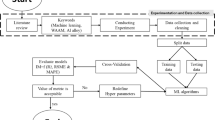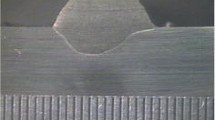Abstract
The objective of this study is to investigate effects of the welding speed, wire feed speed, and torch angle on the weld geometry, including height, width, and depth of metal deposition, in additive manufacturing of mild steel. In the present study, artificial neural network was developed to predict weld bead geometry and validate the optimization of process parameters to improve quality of weld bead geometry. Experimental results for the width, depth, and height of the weld bead geometry were collected, and the interaction effect of the process parameters on the weld bead geometry was investigated. Three-dimensional finite-element modelling was performed for the AM, and the width, depth, and height of the weld geometry were predicted. The Taguchi method-based graph theory and matrix approach and the utility concept were used to optimise the process parameters for achieving the dimensional accuracy in AM. The optimal working condition was as follows: a torch angle of 60°, a wire feed speed of 6 m/min, and a welding speed of 0.4 m/min. Under the optimal working conditions, the height, width, and depth of the weld bead were 3.910, 7.615, and 2.000 mm, respectively. The optimization was also validated with ANN and a comparison among the ANN, simulation and experimental results revealed good agreement.

















Similar content being viewed by others
References
Almeida R, Goh YM, Monfared R, Steiner MTA, West A (2020) An ensemble based on neural networks with random weights for online data stream regression. Soft Comp 24:9835–9855
Azar AS (2015) A heat source model for cold metal transfer (CMT) welding. J Therm Anal Calorim 122(2):741–746
Babu GP, Murthy B, Venkatarao K, Ratnam C (2017) Multi-response optimization in orthogonal turn milling by analyzing tool vibration and surface roughness using response surface methodology. Proc Inst Mech Eng Part B J Eng Manuf 231(12):2084–2093
Cheema MS, Dvivedi A, Sharma AK (2013) A hybrid approach to multicriteria optimization based on user’s preference rating. Proc Inst Mech Eng Part B J Eng Manuf 227(11):1733–1742
Chowdhury S, Mhapsekar K, Anand S (2018) Part build orientation optimization and neural network-based geometry compensation for additive manufacturing process. J Manuf Sci Eng Trans ASME 140(3):031009
Garland AP, White BC, Jared BH, Heiden M, Donahue E, Boyce BL (2020) Deep Convolutional Neural Networks as a Rapid Screening Tool for Complex Additively Manufactured Structures. Addit Manuf 35:101217
Gokhale NP, Kala P, Sharma V (2019) Thin-walled metal deposition with GTAW welding-based additive manufacturing process. J Braz Soc Mech Sci Eng 41(12):1–12
Goldak J, Chakravarti A, Bibby M (1984) A new finite element model for welding heat sources. Metall Trans B 15(2):299–305
Graf M, Hälsig A, Höfer K, Awiszus B, Mayr P (2018) Thermo-mechanical modelling of wire-arc additive manufacturing (WAAM) of semi-finished products. Metals (basel) 8(12):1009
Hu Z, Qin X, Shao T, Liu H (2018) Understanding and overcoming of abnormity at start and end of the weld bead in additive manufacturing with GMAW. Int J Adv Manuf Tech 95(5–8):2357–2368
Jin Y, Du J, He Y (2017) Optimization of process planning for reducing material consumption in additive manufacturing. J Manuf Syst 44:65–78
Kansal HK, Singh S, Kumar P (2006) Performance parameters optimization (multi-characteristics) of powder mixed electric discharge machining (PMEDM) through Taguchi’s method and utility concept. Ind J Eng Mat Sci 13(3):209–216
Kim JH, Wang LS, Putta K, Haghighi P, Shah JJ, Edwards P (2019) Knowledge based design advisory system for multi-material joining. J Manuf Syst 52:253–263
Kucukoglu I, Ulusu HA, Gunduz T, Tokcalar O (2018) Application of the artificial neural network method to detect defective assembling processes by using a wearable technology. J Manuf Syst 49:163–171
Li Y, Xiong J, Yin Z (2019) Molten pool stability of thin-wall parts in robotic GMA-based additive manufacturing with various position depositions. Robot Comput Integr Manuf 56:1–11
Liu C, Law ACC, Roberson D, (James) Kong Z (2019) Image analysis-based closed loop quality control for additive manufacturing with fused filament fabrication, J Manuf Syst, 51: 75–86
Majeed A, Ahmed A, Lv J, Peng T, Muzamil M (2020) A state-of-the-art review on energy consumption and quality characteristics in metal additive manufacturing processes. J Braz Soc Mech Sci Eng 42(5):249
Mehrotra K, Mohan CK, Ranka S (1997) Elements of artificial neural networks. MIT Press, Cambridge
Oyama K, Diplas S, M’hamdi M, Gunnæs AE, Azar AS (2019) Heat source management in wire-arc additive manufacturing process for Al-Mg and Al-Si alloys. Addit Manuf 26:180–192
Qi X, Chen G, Li Y, Cheng X, Li C (2019) Applying neural-network-based machine learning to additive manufacturing: current applications. Chall Future Perspect Eng 5(4):721–729
Rao KV, Murthy B, Rao NM (2016) Experimental study on tool condition monitoring in boring of AISI 316 stainless steel. Proc Inst Mech Eng Part B J Eng Manuf 230(6):1144–1155
Venkata Rao K (2019) A study on performance characteristics and multi response optimization of process parameters to maximize performance of micro milling for Ti-6Al-4V. J Alloys Compd 781:773–782
Venkata Rao K, Murthy PBGSN (2018) Modeling and optimization of tool vibration and surface roughness in boring of steel using RSM, ANN and SVM. J Intell Manuf 29(7):1533–1543
VenkataRao K, Anoop Kumar T, Vidhu KP, Murthy PBGSN, NarayanaRao N, Balaji M (2016) An artificial neural network approach to investigate surface roughness and vibration of work piece in boring of AISI1040 steels. Int J Adv Manuf Tech 83(2016):919–927
Williams SW, Martina F, Addison AC, Ding J, Pardal G, Colegrove P (2016) Wire + Arc Additive Manufacturing. Mater Sci Tech 32(7):641–647
Wu D, Hua X, Ye D, Ma X, Li F (2017) Understanding of the weld pool convection in twin-wire GMAW process. Int J Adv Manuf Tech 8(1–4):219–227
Zhao H, Zhang G, Yin Z, Wu L (2011) A 3D dynamic analysis of thermal behavior during single-pass multi-layer weld-based rapid prototyping. J Mat Proc Tech 211(3):488–495
Zhao Y, Li W, Liu A (2018) Optimization of geometry quality model for wire and arc additive manufacture based on adaptive multi-objective grey wolf algorithm. Soft Comp. https://doi.org/10.1007/s00500-020-05027-y
Funding
This work was not supported by any external funding agencies.
Author information
Authors and Affiliations
Corresponding author
Ethics declarations
Conflict of interest
There are no potential conflicts of interest among the authors.
Human or animal rights
As the present research was done on any human beings and animals, it does not require any informed consent/ permission from anywhere.
Additional information
Publisher's Note
Springer Nature remains neutral with regard to jurisdictional claims in published maps and institutional affiliations.
Rights and permissions
About this article
Cite this article
Venkata Rao, K., Parimi, S., Suvarna Raju, L. et al. Modelling and optimization of weld bead geometry in robotic gas metal arc-based additive manufacturing using machine learning, finite-element modelling and graph theory and matrix approach. Soft Comput 26, 3385–3399 (2022). https://doi.org/10.1007/s00500-022-06749-x
Accepted:
Published:
Issue Date:
DOI: https://doi.org/10.1007/s00500-022-06749-x




